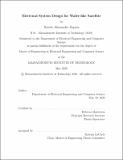Electrical system design for wafer-like satellite
Author(s)
Zapien, Xavier Alexander.
Download1193032035-MIT.pdf (7.156Mb)
Other Contributors
Massachusetts Institute of Technology. Department of Electrical Engineering and Computer Science.
Advisor
Rebecca Masterson.
Terms of use
Metadata
Show full item recordAbstract
The miniaturization of electronics and reduced budgets for satellites have propelled the small-sat revolution for the past two decades[1]. The rapid growth of Small satellites has been driven by the increasing capability of Commercial Off the Shelf (COTS) products and their reduced Size, Weight, and Power (SWaP). This success could potentially be expanded by the use of microelectromechanical systems (MEMS) and microelectronics fabrication processes. MEMS processes have revolutionized the implementation of electronics in silicon wafers, greatly reducing the mass and area needed for components. MEMS could reduce the SWaP of a satellite to drive cost reduction and rapid manufacturing. WaferSat is a MIT Lincoln Laboratory project, with collaboration from the MIT Aero Astro Department, that is developing a wafer-scale satellite bus using microfabrication. One of the first stages of developing WaferSat is proving the concepts and subsystems in a printed circuit board (PCB) form, named PCBSat. PCBSat contains the potential Power, Thermal, and computer subsystems of WaferSat. Designing the system in a PCB allows the student group at MIT to rapidly develop and test the systems that may be introduced into the wafer. If successful, many swarms of WaferSat could be in Low Earth Orbit (LEO) and conduct science with interferometry and other inter-satellite communication protocols. This thesis introduces the high level requirements of the WaferSat bus for exemplar sensing mission, and dives deeper into the design choices and trade-offs taken while designing the power system of the spacecraft. The Maximum Power Point Tracker, Battery Management Systems, and the Power Conversion circuits are designed in this thesis. The main challenges to this miniaturization are found in the power and thermal sub-systems. The small form factor greatly limits the volume to store energy and the area to collect solar energy, creating a focus on efficiency in the power electronics of the system. These systems are developed to leverage past CubeSat designs with modern power efficient architectures and methods. Lastly, the efforts of this project set up the continued development of PCB-like satellites in the field.
Description
Thesis: M. Eng., Massachusetts Institute of Technology, Department of Electrical Engineering and Computer Science, May, 2020 Cataloged from the official PDF of thesis. Includes bibliographical references (pages 121-122).
Date issued
2020Department
Massachusetts Institute of Technology. Department of Electrical Engineering and Computer SciencePublisher
Massachusetts Institute of Technology
Keywords
Electrical Engineering and Computer Science.